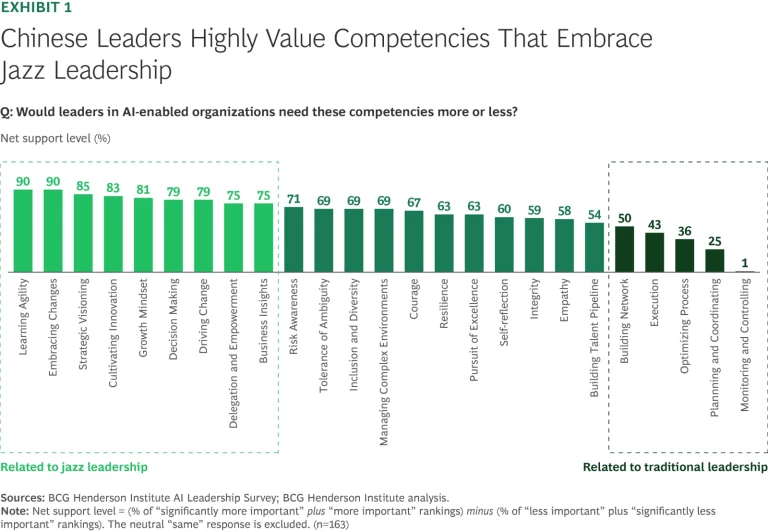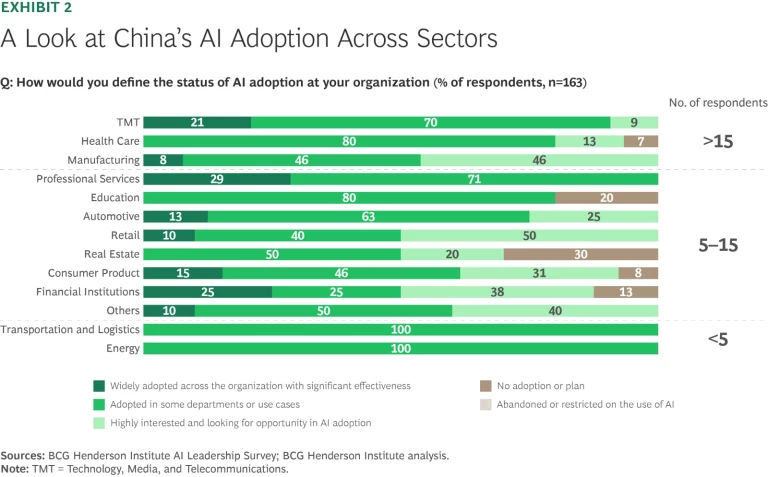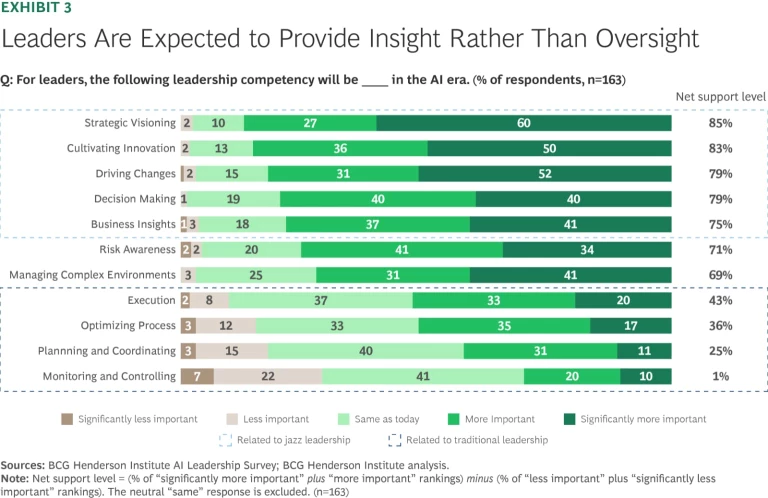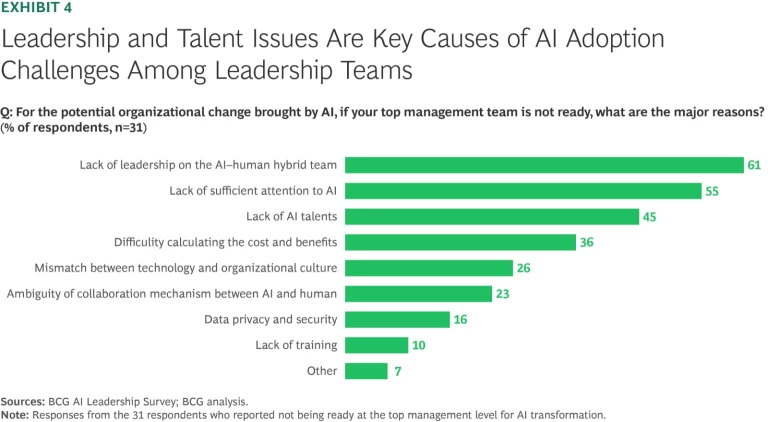The proliferation of AI has led to increasingly decentralized corporate structures and new ways of working. At companies around the world, we’re seeing more democratized skill-building, flatter hierarchies, dismantled organizational divides, and less traditional supervision.
These shifts have profound implications for companies—and for the leaders who run them. Those at the helm of startups or incubators have long understood the leadership style that enables success within their organizations. These are the environments in which jazz leadership has thrived: an ensemble approach that, unlike an orchestra, is free-flowing, collaborative, and able to constantly evolve to create something new.
As AI enables larger companies to adopt many of the characteristics of these smaller, more disruptive organizations, they will need to adapt their leadership style accordingly. This is a key finding from our recent survey of 160 senior executives at Chinese companies representing 13 industries. More than 80% of the companies operate internationally, and half of those companies have more than 10,000 employees.
BCG Henderson Institute: Discover new thinking shaping the business landscape
The results show the rising importance of jazz leadership attributes, emphasizing leaders’ ability to embrace change and cultivate an environment of innovation based on strategic insight, greater delegation, and employee empowerment. (See Exhibit 1.) Significantly, this trend is building momentum at the same time that respondents report a high level of AI adoption. AI also enables this transition by helping leaders who are embracing jazz principles to implement this style of leadership.
In other words, we’re moving into an era of jazz leadership at scale. Think of it as going from a quartet to a 1940s Big Band like those led by Glenn Miller or Benny Goodman. The team is larger and there’s a foundational structure, but improvisation, collaboration, and creativity are an integral part of the sound.

How Business Leaders in China Are Adapting to the AI Age
Our survey shows that Chinese companies are embracing AI. Among respondents in certain sectors—such as technology, media, and telecommunications; professional services; and financial institutions—approximately a quarter report that AI is being adopted across the organization with high effectiveness. On average, 60% of respondents say their company has adopted AI in some departments or for some use cases. (See Exhibit 2.)

What’s more, we find that respondents’ preferences, beliefs, and behaviors related to the technology indicate that they are adapting to this new reality—or are open to doing so. “Leaders in the AI age should be willing to test and even break the old business processes,” an executive at Chinese tech firm Baidu told us. In fact, while AI’s transformative impact on organizations is still evolving, our survey showed that leaders are evolving along with them in some key areas.
Strategic thinking and vision
The survey results indicate first and foremost that strategy is key for company leaders in the AI-age, with 85% of executives reporting that successful leaders at AI-enabled companies must possess strategic vision and three-quarters of respondents saying that business insight is now more important. This is in stark contrast to the low level of support (1%) for monitoring and controlling as vital competencies in the AI age. (See Exhibit 3.)

This shift in what’s expected of organization leaders can be seen in e-commerce player Alibaba and its efforts to incorporate AI to improve its strategic decision making. The company deployed a digital twin to simulate a range of possible, sometimes extreme, situations such as port paralysis, a spike in costs, or the sudden imposition of 100% tariffs. The simulation helped Alibaba’s leaders to develop agility in its supply chain management, allowing them to assess and rank regional hubs based on factors like labor cost, tariff, and efficiency, among others.
Delegation and empowerment
The importance of embracing delegation and empowerment was noted by 75% of executives. These values are related to the collaborative environment fostered by jazz leadership. Gone are the days of micromanaging bosses that oversee every aspect of every process from start to finish.
Respondents said traditional process-related competencies are the least important traits for leaders today: nearly two-thirds said these skills are of less value. Only 25% of executives valued planning and coordinating, and just 1% cited monitoring as vital leadership skills. In fact, execs said that managers who focus heavily on process are the most likely to be eliminated in the AI era. Instead, today’s leaders say the key is providing the minimum sufficient structure to foster a team’s autonomy.
For instance, ByteDance, a global tech firm with Chinese roots, now facilitates bottom-up innovation by supporting employees to explore its AI tools and encouraging workers to share their ideas across Lark, the organization’s collaborative platform. The Chinese home appliance and consumer electronics company Haier has used AI to empower its sales and marketing team. Rather than relying on a traditional leadership hierarchy to identify challenges and come up with solutions, the Haier sales team can now adjust a sales policy on its own based on AI analysis of a particular region, competitor pricing, available inventory, social listening, or even product mix.
Inspiration and empathy
AI has the potential to transform the capabilities of employees, how they acquire and analyze information, ideate and create solutions, and even operate within an organization. It’s important to remember that as AI technology evolves, so too will the ways that humans interact with it. Instead of conducting ongoing direct oversight of employees, leaders will need to continually explore the boundaries of the technology to understand its latest capabilities to best allocate responsibilities between human employees and AI tools. In fact, respondents cite a lack of leadership on the interactions of AI and humans as a major obstacle to AI transformation. (See Exhibit 4.)

This requires leaders to understand not only what humans are capable of, but what makes them tick. This will put greater emphasis on leaders’ ability to understand and nurture employees’ humanity. Executives have already taken notice, with strong levels of support in our survey for leadership attributes like providing inspiration (65%), team building (63%), humanistic care (64%), and empathy (58%), as well as the ability to communicate (53%) with workers.
While AI may help organizations to broadly standardize tasks and execute targets, complex and nonstandard tasks still require human teams, supported by their leaders, to bond under an inspiring vision and culture to work towards common goals. We expect emphasis on these interpersonal traits to grow as AI is more integrated into business operations—where the efficiency of interactions between leaders and human team members will likely improve, but the frequency of interactions may decrease.
SF Express, a delivery services and logistics company, has adopted a people-centric leadership style. Since couriers are the key human assets of the company, SF Express deploys AI to maximize not just their delivery efficiency, but their individual health. By analyzing a particular courier’s historical movements—how often particular deliveries have required bending or heavy lifting—the company is able to predict and anticipate what could be high risk movements for that courier to better avoid injury. And using weather data, AI can adjust courier routing to avoid accidents and injuries.
How AI Enables a New Kind of Leadership at Scale
Historically, startups or incubators that embrace these jazz leadership principles have been nimble, decentralized organizations built around clusters of highly specialized talent. They create a collaborative environment, bristling with energy, that empowers workers to make important decisions and entrusts them to improvise when things don’t go as planned. That dynamic also cultivates a rare tolerance for failure that is considered crucial to fostering the bottom-up creativity and innovation necessary for success.
Making this freewheeling environment work, however, required a new type of leader and a different style of leadership than was typical at traditional companies. Startups and incubators found success with jazz leadership that emphasizes decentralized innovation, creating minimum structures to promote autonomy, and partially shared leadership.
Now the emergence of AI is transforming how traditional large organizations operate in three key ways—speeding up innovation, changing information flows to enable more convenient collaboration, and augmenting talent—which requires a different type of leadership.
- Speeding up innovation with greater tolerance for errors
AI tools, such as digital twins and scenario planning, have helped lower the cost of experimentation. This change in the cost and speed of innovation brought on by AI is also prompting an evaluation of the type of leadership that would be best suited for this changing environment.
In the pharmaceutical sector, for instance, the R&D process was lengthy and success was unpredictable, all of which came with considerable costs. That meant investment and innovation decisions were high stakes—and came from the very top of the company ladder. The use of machine learning and algorithm tools, however, has slashed the time and cost associated with finding new drugs, changing not just the R&D process but the very structure and operations of pharmaceutical companies themselves.
Other industries are also realizing the technology’s potential. The Chinese home appliance design and manufacturing company Midea was able to slash the time spent on product research and development from 18 to 12 months by incorporating AI into its R&D process. Using generative AI-enabled digital twin technology allows the company to cut waste and costs while better predicting energy consumption based on environmental factors.
- Better organizational information flows improve collaboration
The rapid adoption of AI has also made collaboration easier by improving how information is distributed within an organization. AI platforms create greater access to business, finance, risk, and people data for a wider range of employees, enabling them to more easily work together and giving them the tools to generate new insights.
This sort of democratized access and collaboration is a dynamic that one would expect from a tight-knit startup or incubator. Indeed, before AI arrived in large organizations, jazz-like collaboration on expansive teams and across extensive internal value chains would have been impossible. New AI tools like dynamic data integration and analysis now allow for information to be gathered, organized, and disseminated across a team or an entire organization near-instantaneously—promoting collaborative, decentralized decision making.
ByteDance’s Lark platform is built on an embedded knowledge management system that gathers institutional information—ranging from meeting notes to policies, best practices, and beyond—that can be quickly summarized and shared with relevant teams. Individual employees are also empowered to participate and contribute their own insights, formally or informally. At ByteDance, tools like this empower self-driven workers by fostering an environment where innovative ideas can be tested, refined, and later shared widely.
- Talent augmentation to fill skills gaps
While startups and incubators have been able to achieve sufficient talent density to operate in a less structured environment, larger organizations typically have not had enough of the right kind of talent to apply decentralized leadership principles at scale. In instances where each team member must be able to share leadership, talented individuals need to develop skills and expertise in their field, as well as cross-functional knowledge that allows them to effectively collaborate with and support others.
Not only is AI starting to make the knowledge and skills necessary for collaborative leadership more accessible on a larger scale, it is also helping to fill talent gaps. For example, AI-enabled customized learning platforms can help bolster the capabilities of existing talent and enhance talent density.
When Ping’an Insurance, one of the largest insurance companies in China, rolled out its Ask Bob internal AI platform, employee performance improved considerably. Ask Bob has played a positive role in enhancing the professional capabilities of agents. For example, the AI was able to provide tailored expertise on medical, law, and finance on a real-time basis during customer interactions and customize each employee’s ongoing learning journey based on their capability gaps. And with improved tools came improved performance.
Taken together, these changes brought on by AI indicate that constraints on the applicability of jazz principles in large organizations are eroding. By lowering the cost of experimentation, strengthening collaboration, and generating higher talent density, AI lays the groundwork for jazz leadership to be increasingly applied at a larger scale.
Introducing Big Band Leadership
The data from our survey confirmed what we expected was happening beneath the surface in a rapidly changing workplace and marketplace: the beliefs and behaviors of Chinese leaders themselves are evolving to meet the AI-enabled moment. As AI transforms the way more companies organize and operate, executives in China are responding—or are at least aware of the leadership task before them. It’s clear that the new priorities and competencies required of today’s corporate bosses will also require new leadership styles.
We can see these developing trends in the interactions we have with Chinese company leaders day to day, revealing some notable differences from how Western executives are approaching AI.
Business execs in China are pragmatic in adopting AI, prioritizing immediate, short-term impact. This usually leads to focusing on incremental efficiency gains, rather than embracing a holistic plan for overall AI strategy. Without a long legacy in digitalization or processes, these leaders are adaptive and agile in adopting AI, which has made them more willing to embrace mistakes. Chinese leaders have historically been product or customer centric. But with increasing AI adoption, more are taking a people-centric approach that can not only attract more talent, especially AI experts, but also lead to a workforce with a growth mindset that is more willing to embrace change.
In these instances, we’re starting to see the emergence of a self-reinforcing virtuous cycle where AI enables a new kind of leadership, and those leaders are more able to maximize the impact of AI. This, in turn, delivers business success, further driving leadership changes at the top. The emerging forms of leadership we’re seeing across these companies are actually a new spin on an old tune. They are the very jazz principles of collaborative leadership that have been part of startup and incubator culture for decades. We expect the emphasis on creativity and innovation in all its forms will only increase as AI technology advances. This means that more companies will need to rethink their ways of working and, crucially, what kind of music their big band of leaders should be playing.






